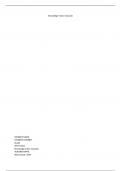Knowledge Track: Inclusion
STUDENT NAME
STUDENT NUMBER
CLASS
28-01-2021
Knowledge track: inclusion
TEACHER NAME
Word count: 3429
,Table of content
1. Target group analysis..........................................................................................................................3
1.1 Target group.................................................................................................................................3
1.2 Living situation..............................................................................................................................3
1.3 Work.............................................................................................................................................3
1.4 Leisure activities...........................................................................................................................4
2. Analysis ‘not being allowed to participate’.........................................................................................5
3. Analysis ‘(not) being able to participate’............................................................................................7
4.1 Macro level...................................................................................................................................8
4.2 Meso level....................................................................................................................................8
5. Conclusion........................................................................................................................................10
6. Literature list....................................................................................................................................11
2
, 1. Target group analysis
In this analysis the target group will be explained by focusing on the exclusion this group faces and
their living and work situation and their leisure activities.
1.1 Target group
The chosen target group is black transgender people in the Unites States. This group has been chosen
since they experience exclusion on many levels which this paper will explore. Among transgender
people almost 16 percent is black, while 55 percent is white(Flores, Brown, Herman, 2016). The
division between male or female is unclear. 0.8 percent of African-American or black adults identify
as transgender (Flores, Brown, Herman, 2016). This group is only a small percentage of people who
live in the U.S. but they are a very excluded group in society.
1.2 Living situation
According to the National LGBTQ Task Force (2021), 41 percent of their black transgender
respondents experienced homelessness in their lives, which is five times the amount of the average
United States population. Homelessness has a big impact on a person and often leads to addiction or
further psychological problems (Murray, 2021). According to Murray (2021), 26% of homeless people
uses substances.
Another problem is eviction, more than one in ten transgender people face eviction, black
transgender people face this even more often (Brantley-Jones, 2021). Eviction is a big problem
amongst transgender people because often their family’s rejection of their gender identity leaves
them homeless. Black transgender people usually do not have a big social safety-net and have no one
to fall back on (Brantley-Jones, 2021). With higher eviction numbers, housing becomes a big issue for
the target group.
Furthermore, poverty is another big part of their living situation, with 34 percent of black
transgender people earning less than 10.000 dollars a year. This classifies as extreme poverty and
only 4 percent of the general U.S. population lives that way (National LGBTQ Task Force, (2021).
Without any money, social exclusion rises since black transgender people cannot participate in
society when they have no money, no strong social circle or housing.
Finally, according to the National LGBTQ Task Force (2021), 49 percent of their black
respondents report having attempted suicide. Among males the suicide rate is even higher than
among females (National Institute of Mental Health, 2021). These numbers are staggering and show
the difficulty transgender people face, even more so when they are black transgender people in the
U.S. These numbers contribute to exclusion for black transgender people, since poverty causes
shame and a feeling of not being able to live up to societies expectation. According to Van Straaten
et al. (2016), ‘homelessness is inherently associated with social exclusion because the characteristics
are intertwined with homelessness, such as lack of housing, financial debts and lack of social
support’. These characteristics are also components of social exclusion.
1.3 Work
Unemployment has big consequences for one’s life, since it can disrupt housing, participation in
social activities and one’s mental health can deteriorate. According to the National LGBTQ Task Force
(2021), the unemployment rate for black transgender people is 26 percent, which is abnormally high.
To compare, this is four times the amount of the general population of the U.S. The reason why these
3




